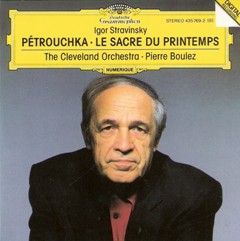111 Years of Deutsche Grammophon - CD 8
111 Years of Deutsche Grammophon - CD 8
Stravinsky: Petrushka; The Rite of Spring

Petrouchka Scene 1 1 First tableau [9:57] Scene 2 2 Second tableau [4:30] Scene 3 3 Third tableau [7:02] Scene 4 4 Fourth tableau [13:29] Le Sacre du Printemps 5 Part 1: L'Adoration de la Terre [15:55] 6 Part 2: Le Sacrifice [17:27] The Cleveland Orchestra Pierre Boulez – conductor
Petrouchka or Petrushka is a ballet composed in 1910–11 and revised in 1947. Petrushka is a story of a Russian traditional puppet, Petrushka, who is made of straw and with a bag of sawdust as his body, but who comes to life and develops emotions. According to Andrew Wachtel, Petrushka is a work that fuses music, ballet, choreography and history in perfect balance. It evokes Richard Wagner's Gesamtkunstwerk (total artwork), but with a Russian approach.
Stravinsky composed the music during the winter of 1910–11 for Sergei Diaghilev's Ballets Russes. It was premièred in Paris at the Théâtre du Châtelet on June 13, 1911 under conductor Pierre Monteux, with choreography by Mikhail Fokine and sets by Alexandre Benois. The title role was danced by Vaslav Nijinsky. One critic approached Diaghilev after a dress rehearsal and said, "And it was to hear this that you invited us?" Diaghilev succinctly replied, "Exactly".[cite this quote] When Diaghilev and his company traveled to Vienna in 1913, the Vienna Philharmonic initially refused to play the score, deriding Petrushka as schmutzige Musik ("dirty music"). The work is characterized by the so-called Petrushka chord (consisting of C major and F♯ major triads played together), a bitonality device heralding the appearance of the main character.
The Rite of Spring, original French title Le sacre du printemps is a ballet with music by Igor Stravinsky; choreography by Vaslav Nijinsky; and concept, set design and costumes by Nicholas Roerich. It was produced by Sergei Diaghilev for his Ballets Russes ballet company and had its première in Paris on 29 May 1913.
The music's innovative complex rhythmic structures, timbres, and use of dissonance have made it a seminal 20th century composition. In 1973, composer and conductor Leonard Bernstein said of one passage, "That page is sixty years old, but it's never been topped for sophisticated handling of primitive rhythms...", and of the work as a whole, "...it's also got the best dissonances anyone ever thought up, and the best asymmetries and polytonalities and polyrhythms and whatever else you care to name."
Last Updated (Thursday, 15 March 2012 15:44)








